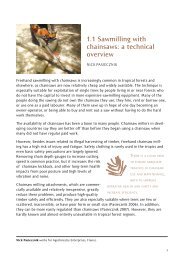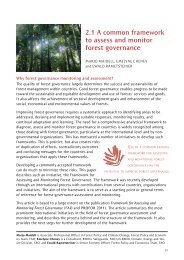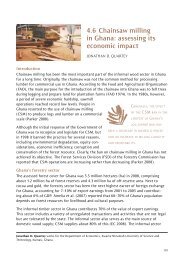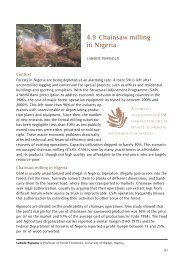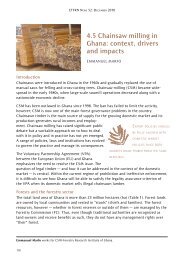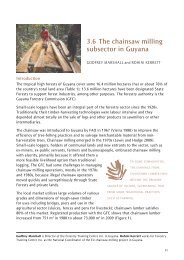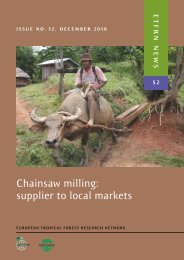Chainsaw milling: supplier to local markets - European Tropical ...
Chainsaw milling: supplier to local markets - European Tropical ...
Chainsaw milling: supplier to local markets - European Tropical ...
You also want an ePaper? Increase the reach of your titles
YUMPU automatically turns print PDFs into web optimized ePapers that Google loves.
ETFRN NEws 52: DEcEmbER 2010<br />
forestry sec<strong>to</strong>r was characterized by a closed corporate structure, consisting of a tightly<br />
defined group of professionals from the government and the timber industry. within this<br />
structure, the legal procedures for timber exploitation focused mainly on technical norms<br />
for contractually agreed timber production, and on<br />
financial norms regarding payments of duties <strong>to</strong> the<br />
government for exploitation of national forest resources.<br />
The past decades saw changes in forestry regimes in many<br />
tropical countries as decentralized forms of forest<br />
management developed. The basic principle underlying this<br />
development was that civil and grassroots organizations<br />
— not just government and the timber industry — should<br />
be involved in forestry policies. This new approach is often<br />
referred <strong>to</strong> by the term “forest governance.” it involves<br />
a multi-stakeholder process of decision-making on and<br />
implementation of forest use and management, with specific attention <strong>to</strong> the purposes<br />
for which forests are managed and <strong>to</strong> the equitable access of different stakeholders <strong>to</strong><br />
decision-making and implementation processes (lemos and agrawal 2006).<br />
This decentralized forest governance regime is based on several considerations:<br />
• sustainable forest use and management involve the reconciliation of different<br />
ecological, economic and social forest values held by different stakeholder groups;<br />
• forest values are expressed at different levels of society, represented by global<br />
environmental concerns (such as biodiversity conservation and climate change<br />
mitigation), national economic and environmental concerns, and <strong>local</strong> livelihood<br />
needs;<br />
• profiting from forest resources and services must be just and fair, reflected in norms<br />
such as participation, empowerment and equity;<br />
• efficient management is assured if people who are directly dependent on forest<br />
resources are involved in the management; and<br />
• the combination of a participa<strong>to</strong>ry approach and effective management allows for<br />
transparency and accountability in implementing governance rules and regulations.<br />
at first, a dual forestry regime — consisting of the traditional forestry sec<strong>to</strong>r and a social<br />
forestry sec<strong>to</strong>r — seemed <strong>to</strong> be the best approach. but with the gradual development of a<br />
variety of decentralized forest management systems, this notion has been replaced by the<br />
notion of forestry regimes that are characterized by a variety of multi-ac<strong>to</strong>r partnerships<br />
(lemos and agrawal 2006). although the need <strong>to</strong> recognize different forestry regimes is<br />
now well accepted in respect <strong>to</strong> forest management, the notion has received much less<br />
attention in respect <strong>to</strong> timber trade and manufacturing. programmes on stimulating<br />
timber legality are still based mostly on concepts related <strong>to</strong> the traditional forestry<br />
regime, and give little attention <strong>to</strong> the presence of small-scale, artisanal timber harvesting<br />
and manufacturing systems.<br />
206



